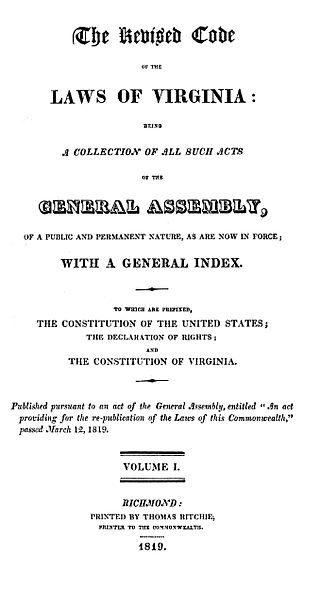External links
| | This legislation article is a stub. You can help Wikipedia by expanding it. |
The Nevada Revised Statutes (NRS) are all the current codified laws of the State of Nevada. Nevada law consists of the Constitution of Nevada (the state constitution) and Nevada Revised Statutes. The Nevada Supreme Court interprets the law and constitution of Nevada. The Statutes of Nevada are a compilation of all legislation passed by the Nevada Legislature during a particular Legislative Session. The Nevada Administrative Code (NAC) is the codified, administrative regulations of the Executive Branch. The Nevada Register is a compilation of proposed, adopted, emergency and temporary administrative regulations, notices of intent and informational statements. Nevada Supreme Court Opinions are the written decisions of the Nevada Supreme Court.
In the United States, state law refers to the law of each separate U.S. state.

The Code of Virginia is the statutory law of the U.S. state of Virginia, and consists of the codified legislation of the Virginia General Assembly. The 1950 Code of Virginia is the revision currently in force. The previous official versions were the Codes of 1819, 1849, 1887, and 1919, though other compilations had been printed privately as early as 1733, and other editions have been issued that were not designated full revisions of the code.
The Ohio Revised Code contains all current statutes of the Ohio General Assembly of a permanent and general nature, consolidated into provisions, titles, chapters and sections. However, the only official publication of the enactments of the General Assembly is the Laws of Ohio; the Ohio Revised Code is only a reference.

Law in the state of Louisiana is based on a more diverse set of sources than the laws of the other 49 states of the United States. Private law—that is, substantive law between private sector parties, principally contracts and torts—has a civil law character, based on French and Spanish codes and ultimately Roman law, with some common law influences. Louisiana's criminal law largely rests on American common law. Louisiana's administrative law is generally similar to the administrative law of the federal government and other states. Louisiana's procedural law is generally in line with that of other U.S. states, which in turn is generally based on the U.S. Federal Rules of Civil Procedure.

The law of California consists of several levels, including constitutional, statutory, and regulatory law, as well as case law. The California Codes form the general statutory law, and most state agency regulations are available in the California Code of Regulations.
The law of Florida consists of several levels, including constitutional, statutory, and regulatory law, as well as case law and local law. The Florida Statutes form the general statutory law of Florida.
The law of Colorado consists of several levels, including constitutional, statutory, regulatory, local, and case law. The Colorado Revised Statutes form the general statutory law.
The law of Virginia consists of several levels of legal rules, including constitutional, statutory, regulatory, case law, and local laws. The Code of Virginia contains the codified legislation that define the general statutory laws for the Commonwealth.

The law of New York consists of several levels, including constitutional, statutory, regulatory and case law, and also includes local laws, ordinances, and regulations. The Consolidated Laws form the general statutory law.
The law of Texas is derived from the Constitution of Texas and consists of several levels, including constitutional, statutory, regulatory law, as well as case law and local laws and regulations.
The law of Illinois consists of several levels, including constitutional, statutory, and regulatory law, as well as case law and local law. The Illinois Compiled Statutes (ILCS) form the general statutory law.
The law of Pennsylvania consists of several levels, including constitutional, statutory, regulatory and case law. The Pennsylvania Consolidated Statutes form the general statutory law.
The law of Ohio consists of several levels, including constitutional, statutory, and regulatory, local and common law. The Ohio Revised Code forms the general statutory law.
The law of the U.S. state of Georgia consists of several levels, including constitutional, statutory, and regulatory law, as well as case law and local law. The Official Code of Georgia Annotated forms the general statutory law.
The law of Michigan consists of several levels, including constitutional, statutory, regulatory and case law. The Michigan Compiled Laws form the general statutory law.
The law of North Carolina consists of several levels, including constitutional, statutory, regulatory, case law, and local law.
The law of New Jersey consists of several levels, including constitutional, statutory, regulatory, case law, and local law.
The law of Massachusetts consists of several levels, including constitutional, statutory, regulatory, case law, and local ordinances. The General Laws of Massachusetts form the general statutory law.
The law of the U.S. state of Minnesota consists of several levels, including a state constitution, statutes, session law, administrative rules, and other forms of law.
The law of Washington consists of several levels, including constitutional, statutory, regulatory and case law, as well as local ordinances. The Revised Code of Washington forms the general statutory law.